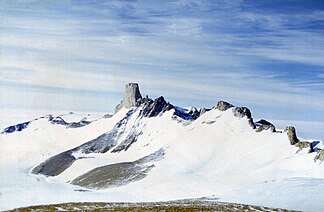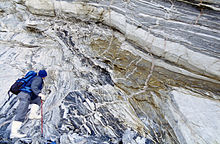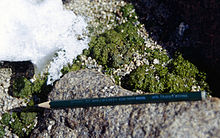Mayr chain
| Mayr chain | ||
|---|---|---|
|
Eastern part of the Mayr chain seen from the southwest, the striking Jutulhogget in the center of the picture |
||
| Highest peak | (unnamed) ( 2370 m ) | |
| location | Queen Maud Land , East Antarctica | |
| part of | Gjelsvikfjella | |
|
|
||
| Coordinates | 72 ° 3 ′ S , 2 ° 45 ′ E | |
The Mayrkette ( Norwegian Jutulsessen , translated: "Big Seat") is a mountain range in Neuschwabenland , whose ice-free peaks and nunataks extend over an area of 30 kilometers in a north-south direction and about 17 kilometers in an east-west direction. The distance to the edge of the ice shelf is about 200 kilometers. The mountains were named after the German pilot Rudolf Mayr , who, as a participant in the German Antarctic Expedition 1938/39, discovered the mountains from the air in January 1939. The Mayr range is the largest mountain range in Gjelsvikfjella. On its western edge is the Norwegian research station Troll , from which biological , geological , glaciological and meteorological studies have been carried out since 1990 .
geography
The Jutulsessen has map image around the shape of the letter W with two north open Karen and a far-reaching north eastern ridge named Armlenet . The highest peak of the Mayr range is an unnamed elevation of 2370 m , which juts out of the inland ice as Nunatak in the southeast of the mountains . The highest named peak is the 2020 m high Jutulhogget . In the north the mountain range dissolves into a series of individual nunataks with heights between 1300 and 1400 m , in the south individual nunataks, which are separated from each other by inland ice, protrude from the glaciated polar plateau . The Mayr Range is bordered by its neighboring mountains by crevasse glaciers . The Sveabreen in the west separates the Mayr chain from the Sverdrupfjella . In the east the Slithallet forms the border to the Risemedet , in the south the Bakhallet separates the Mayr chain from Nupskammen and Terningskarvet , which all belong to Gjelsvikfjella.
geology
The mountain range consists of highly metamorphic , multiply folded gneisses and amphibolites , the parent rocks of which are volcanic rocks and granites of an island arc with a Mesoproterozoic age. At the turn of the Mesoproterozoic to the Neoproterozoic , these rocks were first deformed and metamorphically shaped when the arch of the island collided with the Kaapvaal craton , with the temperature exceeding the melting point for granites and local formation of migmatites . Melts with a granitic and tonalitic composition penetrated from the deeper earth's crust and the upper mantle and solidified in the form of thin ducts.
The rocks underwent a further deformation when the West and East Gondwana collided around 540 mya , which resulted in today's fold structure . At the north edge of the mountain, towards the end of the mountain formation phase, a syenite penetrated , which protrudes as a prominent rock tower. The mountains have been subject to erosion since the Ordovician . In some places you can find Upper Jurassic basalt dikes , which prove that when Gondwana broke up, large amounts of lava were extracted in this region .
climate
Since there was no continuously manned station in the Mayr chain up to 2005, there are no long-term climatic observations. As far as we know from previous observations, temperatures are below freezing all year round. The highest temperatures are reached in January at −2 ° C; in protected areas up to +2.5 ° C have been measured, which allows lower plants to grow. The average temperature was derived from measurements in 15 m deep snow shafts and is around −20 ° C to −23 ° C at 700–1100 m above sea level on the northern edge of the mountains.
fauna and Flora
The fauna of the Mayr range includes one species of springtails and three species of mites , as well as three species of birds that have their summer breeding grounds in the mountains. The two open cirques with extensive, stable rubble and moraine cover offer the birds suitable breeding grounds. In the vicinity of these breeding sites, small organisms that feed on bird droppings and food residues also find a suitable habitat. The two most common bird species are the Antarctic petrel ( Thalassoica antarctica ) with over 60,000 specimens and the snow petrel ( Pagodroma nivea ) with about 2,000 specimens in the mid-1980s, as well as the predatory southern polar skua (Catharacta maccormicki) , of which about 100 specimens were counted.
Mites are represented by the species Eupodes angardi and Tydeus erebus , which are widespread in many mountain regions of Dronning Maud Lands, and the species Maudheimia marshalli COETZEE, newly described in 1997 , which has so far only been detected in the Gjelsvikfjella and the immediate western and eastern neighboring mountains .
Springtails are represented by the species Cryptopygus sverdrupi , which occurs in the central Dronning Maud Land mainly in small moss or algae colonies.
The vegetation in the Mayr range is limited to mostly north-facing, stable scree slopes and rocky surfaces; the occurrences are often close to breeding sites. There the green alga Prasiola crispa occurs in small mats a few decimeters in diameter. Further genera in a less nitrate-rich environment are Nostoc , Ulothrix and Leproloma .
The mosses Grimmia lawiana and Sacroneurum glaciale occur in two specially protected places on the Nunataks north of the Mayr range .
Frequent crusty lichens such as Rhizocarpon geographicum , Xanthoria elegans and Candelariella hattensis colonize the somewhat more weathered parts of the silicate rocks. About a dozen other types of lichen are also known, of which Xanthoria candelaria and Physcia caesia are restricted to the vicinity of breeding grounds.
Discovery and Exploration
On January 29, 1939, the Mayr chain was discovered during image flight IV of the German Antarctic Expedition 1938/39 and documented with aerial photographs . Since most of the aerial photos were lost in World War II, the cartographic representation of the region was flawed due to missing control points on the ground. During the Norwegian Antarctic Expedition 1956–1960, the area was again recorded photogrammetrically and control points were also measured for more precise orientation. On the Norwegian maps of the Dronning Maud Land published since 1959, many objects were given new Norwegian names, since at that time it was no longer possible to precisely localize the names given on the German maps.
The first geological research took place as part of the 4th Soviet Antarctic Expedition 1958-1960. The systematic mapping and exploration was continued from 1989–1990 by Norwegian expeditions that used the Troll station, which opened in 1989, for this purpose .
literature
- K. Brunk: Cartographic work and German naming in Neuschwabenland, Antarctica (= German Geodetic Commission [Hrsg.]: Series E: History and development of geodesy . Volume 24 / I ). 1986 ( 141.74.33.52 [PDF; 382 kB ; accessed on April 19, 2009]).
- Norsk Polarinstitutt (ed.): Blad H5 Jutulgryta (topographic map 1: 250,000) . Oslo 1961.
- Norsk Polarinstitutt (ed.): Blad H6 HU Sverdrupfjella (topographic map 1: 250,000) . Oslo 1961.
- Directory of German geographical names in the Antarctic . In: Institute for Applied Geodesy (ed.): News from the map and surveying system . Special issue, 1993 ( Version 2.14 from June 13, 2014 at stagn.de [accessed October 17, 2016]).
- Yoshihide Ohta (Ed.): Gjelsvikfjella & Western Mühlig-Hofmannfjella Sheets 1 and 2 . Temakart 24. Norsk Polarinstitutt, Tromsø 1999, p. 1–37, 2 ct .
Web links
- Australian Antarctic Division datasheet , accessed March 18, 2014.
Individual evidence
- ^ J. Jacobs, W. Bauer, CM Fanning: New age constraints for Grenville-age metamorphism in western central Dronning Maud Land (East Antarctica), and implications for the palaeogeography of Kalahari in Rodinia . In: International Journal of Earth Sciences . tape 92 , 2003, p. 301-315 .
- ↑ Yoshihide Ohta (Ed.): Gjelsvikfjella & Western Mühlig-Hofmannfjella Sheets 1 and 2 . Temakart 24. Norsk Polarinstitutt, Tromsø 1999, p. 2-3 .
- ↑ Yoshihide Ohta (Ed.): Gjelsvikfjella & Western Mühlig-Hofmannfjella Sheets 1 and 2 . Temakart 24. Norsk Polarinstitutt, Tromsø 1999, p. 33 .
- ^ L. Coetzee: The Antarctic mite genus Maudheimia (Akari, Oribatida) . In: Navorsinge van die Nasionale Myseum Bloemfontein . tape 13 , 1997, pp. 393-425 .
- ↑ Y. Gjessing, DO Øvstedal: Micro Climates and water budget of algae, lichens and moss on a handsome nunataks in Queen Maud Land . In: International Journal of Biometeorology . tape 33 , 1989, pp. 272-281 .
- ↑ Torstein Engelskjøn: Botany of two Antarctic mountain ranges: Gjelsvikfjella and Mühlig-Hofmannfjella, Dronning Maud Land . In: Polar Research . tape 4 , 1986, pp. 205-224 .
- ↑ View of the eastern part of the Mayr range from the north, oblique aerial view from Bildflug VI



